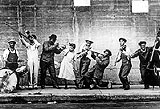By Nekesa Mumbi Moody
Associated Press
It may be too much to expect a TV documentary to restore jazz to the mass popularity it enjoyed decades ago.
 |
| The King Oliver Band performs on a San Francisco sidewalk in this undated photo, which was featured in the PBS series “Jazz,” a 10-part documentary by Ken Burns. The series boosted sales of jazz CDs.
Associated Press |
But Ken Burns’ voluminous and talked-about "Jazz," which wrapped up last week on PBS, has created a surge of interest in the music.
CD sales are up, a companion book is debuting on the New York Times best-seller list next week and some jazz institutions say their programs are evoking more interest.
The wave of interest comes along with criticism from some jazz purists that the series left out key artists, obscured some history and crammed the last 40 years of jazz into the final episode.
Even that debate, however, has been welcomed by many jazz enthusiasts.
"That means people are paying attention," said Karen Johnson, general manager of Jazz at Lincoln Center, in New York City.
She and others hope that novices who tuned in to the 10-part series to learn more will become lifelong fans, appreciating not only jazz’s history but contemporary jazz, too.
"I know personally I talked to a number of friends who are not jazz buyers or listeners who found themselves hooked on this series," said Bill McFarlin, executive director of the Manhattan, Kan.-based International Association of Jazz Educators.
He acknowledged the omissions of "Bill Evans, Chick Corea, Pat Metheny and a number of others who have obviously had an impact on this evolution of music." But he noted that Burns never intended to give a definitive history.
"In context of what the intentions were, I think that the end result will be positive," McFarlin said.
The documentary, which Burns called the last in a trilogy that began with 1990’s "The Civil War" and continued with 1994’s "Baseball," began airing Jan. 8.
Although final ratings figures haven’t been determined, "Jazz" doubled PBS’ prime-time viewership and averaged about a 3.6 rating, said Harry Forbes, a network spokesman. That’s lower than Burns’ baseball series, which averaged a 5.1 rating, and civil war documentary, at 9.0.
Yet "Jazz" was more successful than PBS had predicted, Forbes said, considering that other jazz specials over the years — the Newport Jazz Festival or "Live from Lincoln Center" — have not done as well.
"What’s extraordinary with these jazz ratings is traditionally jazz does not do well on PBS, or presumably anywhere else," he said.
"Jazz" even did better than a five-part series the network aired a few years ago on the history of rock. "Rock ’n’ roll is certainly the most popular genre, (yet) that only averaged a 3.3," Forbes said.
Columbia and Verve Records jointly released 24 recordings in conjunction with the series, all with the stamp of "Ken Burns Jazz."
The five-disc "Ken Burns Jazz: The Story of America’s Music" has been certified gold, with more than 500,000 sold.
In addition, Billboard lists seven "Ken Burns" CDs dedicated to the work of individual artists such as Louis Armstrong among the top 10 selling jazz albums in the country.
And the increase in album sales has not been limited to the Burns titles. The traditional jazz market has seen at least $1 million more in sales since the series began, said Michael Kauffman, senior vice president of sales and marketing at Verve.
"Jazz sales in the United States last fall were roughly a little over
2 percent of sales," he said. Since the series, "we’ve seen the sales go up to just over 4 percent."
While that might not seem like much of an increase, for the jazz world it’s huge, he said.
[back to top] |

 The Great Index to Fun
The Great Index to Fun